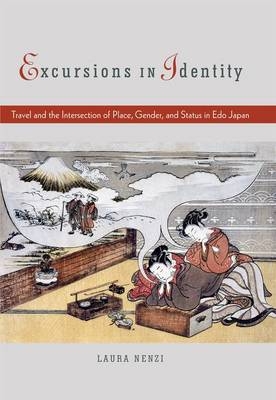
Excursions in Identity
Travel and the Intersection of Place, Gender, and Status in Edo Japan
Seiten
2008
University of Hawai'i Press (Verlag)
978-0-8248-3117-2 (ISBN)
University of Hawai'i Press (Verlag)
978-0-8248-3117-2 (ISBN)
- Titel ist leider vergriffen;
keine Neuauflage - Artikel merken
In the Edo period (1600-1868), status- and gender-based expectations defined a person's place and identity in society. This title introduces the notion that the spaces of travel were malleable, accommodating reconceptualization across interpretive frames. It looks at the intersection between recreational travel and the rising commercial economy.
In the Edo period (1600-1868), status- and gender-based expectations largely defined a person's place and identity in society. The wayfarers of the time, however, discovered that travel provided the opportunity to escape from the confines of the everyday. Cultured travelers of the seventeenth and eighteenth centuries wrote travel memoirs to celebrate their profession as belle-lettrists. For women in particular the open road and the blank page of the diary offered a precious opportunity to create personal hierarchies defined less by gender and more by culture and refinement.After the mid-eighteenth century - which saw the popularization of culture and the rise of commercial printing - textbooks, guides, comical fiction, and woodblock prints allowed not a few commoners to acquaint themselves with the historical, lyrical, or artistic pedigree of Japan's famous sites. By identifying themselves with famous literary and historical icons of the past, some among these erudite commoners saw an opportunity to rewrite their lives and re-create their identities in the pages of their travel diaries.The chapters in Part One, ""Re-creating Spaces,"" introduce the notion that the spaces of travel were malleable, accommodating reconceptualization across interpretive frames. Laura Nenzi shows that, far from being static backgrounds, these travelscapes proliferated in a myriad of loci where one person's center was another's periphery. In Part Two, ""Re-creating Identities,"" we see how, in the course of the Edo period, educated persons used travel to, or through, revered lyrical sites to assert and enhance their roles and identities. Finally, in Part Three, ""Purchasing Re-creation,"" Nenzi looks at the intersection between recreational travel and the rising commercial economy, which allowed visitors to appropriate landscapes through new means: monetary transactions, acquisition of tangible icons, or other forms of physical interaction.
In the Edo period (1600-1868), status- and gender-based expectations largely defined a person's place and identity in society. The wayfarers of the time, however, discovered that travel provided the opportunity to escape from the confines of the everyday. Cultured travelers of the seventeenth and eighteenth centuries wrote travel memoirs to celebrate their profession as belle-lettrists. For women in particular the open road and the blank page of the diary offered a precious opportunity to create personal hierarchies defined less by gender and more by culture and refinement.After the mid-eighteenth century - which saw the popularization of culture and the rise of commercial printing - textbooks, guides, comical fiction, and woodblock prints allowed not a few commoners to acquaint themselves with the historical, lyrical, or artistic pedigree of Japan's famous sites. By identifying themselves with famous literary and historical icons of the past, some among these erudite commoners saw an opportunity to rewrite their lives and re-create their identities in the pages of their travel diaries.The chapters in Part One, ""Re-creating Spaces,"" introduce the notion that the spaces of travel were malleable, accommodating reconceptualization across interpretive frames. Laura Nenzi shows that, far from being static backgrounds, these travelscapes proliferated in a myriad of loci where one person's center was another's periphery. In Part Two, ""Re-creating Identities,"" we see how, in the course of the Edo period, educated persons used travel to, or through, revered lyrical sites to assert and enhance their roles and identities. Finally, in Part Three, ""Purchasing Re-creation,"" Nenzi looks at the intersection between recreational travel and the rising commercial economy, which allowed visitors to appropriate landscapes through new means: monetary transactions, acquisition of tangible icons, or other forms of physical interaction.
Laura Nenzi is assistant professor of history at Florida International University.
| Zusatzinfo | 11 illustrations, 3 maps |
|---|---|
| Verlagsort | Honolulu, HI |
| Sprache | englisch |
| Gewicht | 558 g |
| Themenwelt | Reisen ► Reiseberichte ► Asien |
| Geschichte ► Teilgebiete der Geschichte ► Kulturgeschichte | |
| ISBN-10 | 0-8248-3117-9 / 0824831179 |
| ISBN-13 | 978-0-8248-3117-2 / 9780824831172 |
| Zustand | Neuware |
| Haben Sie eine Frage zum Produkt? |
Mehr entdecken
aus dem Bereich
aus dem Bereich
der stille Abschied vom bäuerlichen Leben in Deutschland
Buch | Hardcover (2023)
C.H.Beck (Verlag)
CHF 32,15
vom Mittelalter bis zur Gegenwart
Buch | Softcover (2024)
C.H.Beck (Verlag)
CHF 16,80


